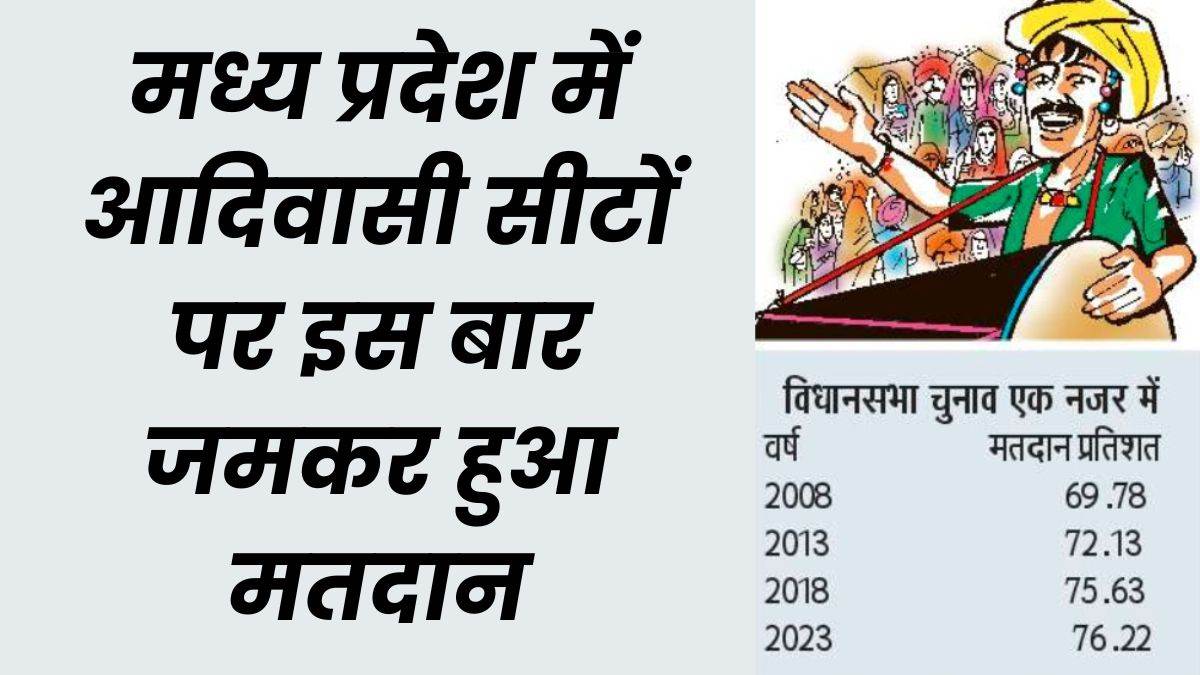Note4Students
From UPSC perspective, the following things are important :
Prelims level: Sixth Schedule and PESA
Mains level: tribal politics

Central idea
The article explores the significant role of tribal votes in the 2023 Madhya Pradesh assembly election, focusing on the competition between Congress and BJP for tribal support. It traces the historical evolution of tribal politics in the region, highlighting key factors influencing tribal voting patterns. The central theme revolves around the ongoing battle for tribal empowerment, with promises and challenges shaping the political landscape in Madhya Pradesh.
Key Highlights:
- Tribal Electoral Battleground: The 2023 Madhya Pradesh assembly election is marked by a fierce struggle between Congress and BJP for the pivotal tribal vote, constituting 21% of the state’s population.
- Political Activism: Over decades, tribal communities have become politically active, influencing electoral outcomes and reshaping the state’s political dynamics.
- Historical Contestation: The political contest for tribal support intensified in the 1990s, with Congress historically dominant but facing challenges as the BJP strategically entered tribal areas.
- Fluid Voting Patterns: Tribal voting, historically with Congress, has witnessed shifts, creating a dynamic landscape for both major parties.
Challenges:
- Shifting Political Alliances: Historical Congress dominance faces challenges, with BJP making strategic inroads, making the tribal vote a pivotal factor.
- Unresolved Policy Demands: Tribals express concerns about autonomy, job creation, forest conservation, and access to government welfare schemes, posing challenges for effective electoral strategies.
- Dynamic Tribal Voting: The fluid nature of tribal voting patterns adds complexity to electoral strategies, requiring adaptable and responsive political approaches.
- Competing Electoral Narratives: The battle for tribal votes involves competing promises and narratives, with Congress emphasizing empowerment through policies like the Sixth Schedule and PESA, while BJP highlights welfare initiatives and cultural ties.
Key Phrases:
- Empowerment Pledges: Congress commits to implementing the Sixth Schedule, enacting PESA, and raising tendu patta rates. BJP emphasizes welfare initiatives and cultural connections.
- Political Mobilization: Grassroots efforts by Vanvasi Kalyan Parishad and RSS play a pivotal role in BJP’s success in tribal areas.
- Party Dynamics: The rise and decline of smaller parties like GGP and the emergence of JAYS signify the evolving political landscape in tribal-dominated regions.
- Historical Turnovers: Post-Independence, Congress dominance in tribal areas faced challenges, with a bi-polar contest emerging in the 2003 elections and subsequent turnovers.
Analysis:
- Political Dynamics: The historical shift from Congress to BJP dominance in tribal areas reflects evolving political strategies and grassroots mobilization.
- Voter Behavior: Grievances against the Shivraj Singh Chouhan-led BJP government and demands for autonomy, job creation, and forest rights significantly influenced tribal voting patterns in the 2018 elections.
- Historical Voting Trends: The 2003 elections marked the beginning of a bi-polar contest, with Congress gaining ground in 2008 and 2018, showcasing the dynamic nature of tribal votes.
- Influence of Grassroots Movements: The sustained efforts of organizations like Vanvasi Kalyan Parishad and RSS contributed to BJP’s success in entering tribal areas.
Key Data:
- Tribal Population Impact: Constitutes 21% of Madhya Pradesh, with 48 out of 230 assembly seats reserved for tribal communities.
- Voter Turnout Surge: Tribal voter turnout rises significantly, reaching 76.39% in the 2018 assembly elections, indicating increased political consciousness.
- Party Strength: Congress relies on tribal leaders like Umang Singhar, Bala Bachchan, and Kantilal Bhuria for securing seats in tribal-dominated areas.
- BJP Initiatives: BJP highlights the appointment of Droupadi Murmu as the first tribal woman president and announces a Rs 24,000 crore welfare program for tribal communities.
Key Facts:
- Prominent Figures: Congress relies on tribal leaders like Umang Singhar, Bala Bachchan, and Kantilal Bhuria to secure seats in tribal-dominated areas.
- BJP Initiatives: BJP highlights the appointment of Droupadi Murmu as the first tribal woman president and announces a Rs 24,000 crore welfare program for tribal communities.
- Shift in Voting Patterns: The 2018 elections witnessed a reversal, with Congress obtaining 32 seats and BJP 16, reflecting changing voter sentiments.
- Role of Grassroots Movements: Organizations like Vanvasi Kalyan Parishad and RSS played a crucial role in BJP’s success in entering tribal areas.
Way Forward:
- Inclusive Policies: Future success hinges on inclusive policies addressing tribal demands for autonomy, job opportunities, and access to welfare schemes.
- Collaborative Governance: A collaborative approach between mainstream parties and tribal communities is crucial to ensure effective representation and address long-standing grievances.
- Responsive Electoral Strategies: Adaptable and responsive political approaches are essential to navigate the dynamic nature of tribal voting patterns.
- Effective Policy Implementation: Resolving policy demands related to autonomy, job creation, forest conservation, and welfare schemes becomes pivotal in securing tribal votes.
Get an IAS/IPS ranker as your 1: 1 personal mentor for UPSC 2024
